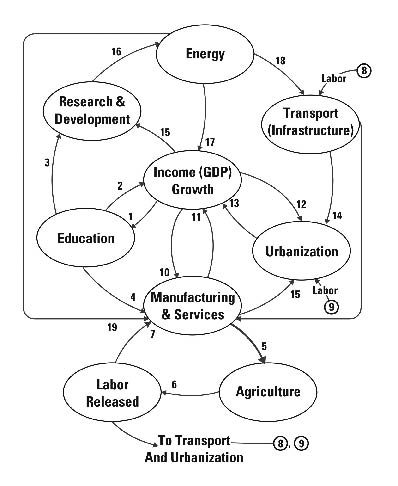|
The diagram on the next page illustrates some of the linkages among the various sectors of the economy. Since the linkages are dynamic, representing them in a static diagram has its challenges. Compounding that is the problem that everything is connected to everything else. Therefore the diagram is a gross simplification of what actually happens in a modern complex economy. The diagram is a model which points out some salient high-level features while ignoring the fine grain details, and is meant to be suggestive of the reality rather than an exact representation.
We can understand the model starting at any arbitrary point. Let’s begin with “Income (GDP) Growth” and note how it is connected to the various sectors.
The numbers enclosed in curly brackets, {n}, below indicate link labels.
{1, 2}: “Income (GDP) growth” and “Education”
Income growth is a consequence of an educated population, and higher incomes translate into higher demand for education.
{4}: “Education” and “Manufacturing & Services”
The education sector provides educated and high-skilled labor to the manufacturing and services sectors, which increases the productivity of those sectors.
{5, 6, 7}: “Manufacturing & Services” and “Agriculture”
M & S provide inputs to agriculture, which increases agricultural productivity. Increased productivity releases labor from agriculture which is absorbed into the growing M&S sectors. (Link between education and the “Labor Released” exists – but is not shown.)
{8, 9}: “Labor Released”, “Transport” and “Urbanization”
Part of the labor released is absorbed in “Transport” – which is a catch-all for infrastructure – and it includes such things as railways, roads, ports, airports, and other large civil works. Part of the labor released is also engaged in “Urbanization,” which is a catch-all for the building of cities.
{10, 11}: “Manufacturing & Services” and “Income (GDP) Growth”
M&S sectors have higher productivity and therefore higher incomes. With the growth of those sectors (relative to the agricultural sector), the GDP of the economy increases. Growth in incomes, in turn, increases the demand for the output of the M&S sectors.
{12, 13}: “Income (GDP) Growth” and “Urbanization”
Urbanization of the population is a cause as well as a consequence of economic growth. People living in cities are more productive than people living in villages, and consequently their incomes are higher. With increasing incomes, people prefer to live in cities because cities provide greater opportunities to them.
{3, 15}: “R&D”, “Education” and “Income (GDP) Growth”
The education sector supplies the human capital for research and development. Higher GDP means that there is more funding available for investing in R&D.
{16}: “R&D” and “Energy”
The output of R&D is inputs to various sectors. For simplicity, we focus on energy alone as the sector that absorbs the output of R&D. The energy sector becomes more efficient as a result.
{17}: “Energy” and “Income (GDP) Growth”
With more energy available, incomes go up. For simplicity, the linkage between energy and the manufacturing & services sectors is not shown. The growth of manufacturing requires energy, and income growth is related manufacturing by {11} as mentioned before.
{18}: “Energy” and “Transportation”
An efficient transportation is an absolute for an economy. Energy is required for building and operating that and other infrastructure of the economy.
{14}: “Transportation” and “Urbanization”
Urbanization means that people live and work in cities, which of course implies that they have to move within and between cities. The transportation (and other infrastructure components) have to keep pace with the urbanization of the population.
We will now explore some of these topics in the next few chapters.
 |


